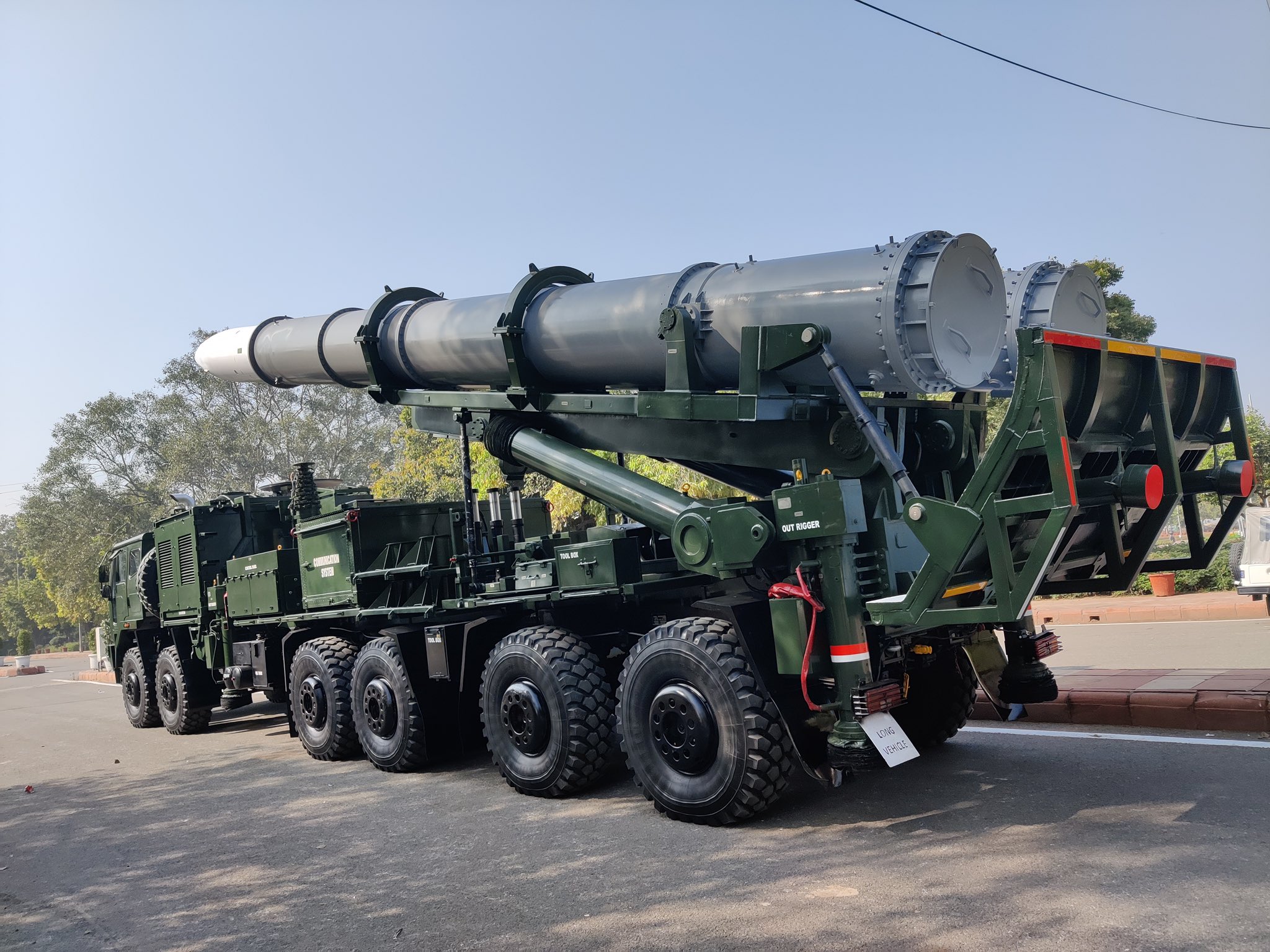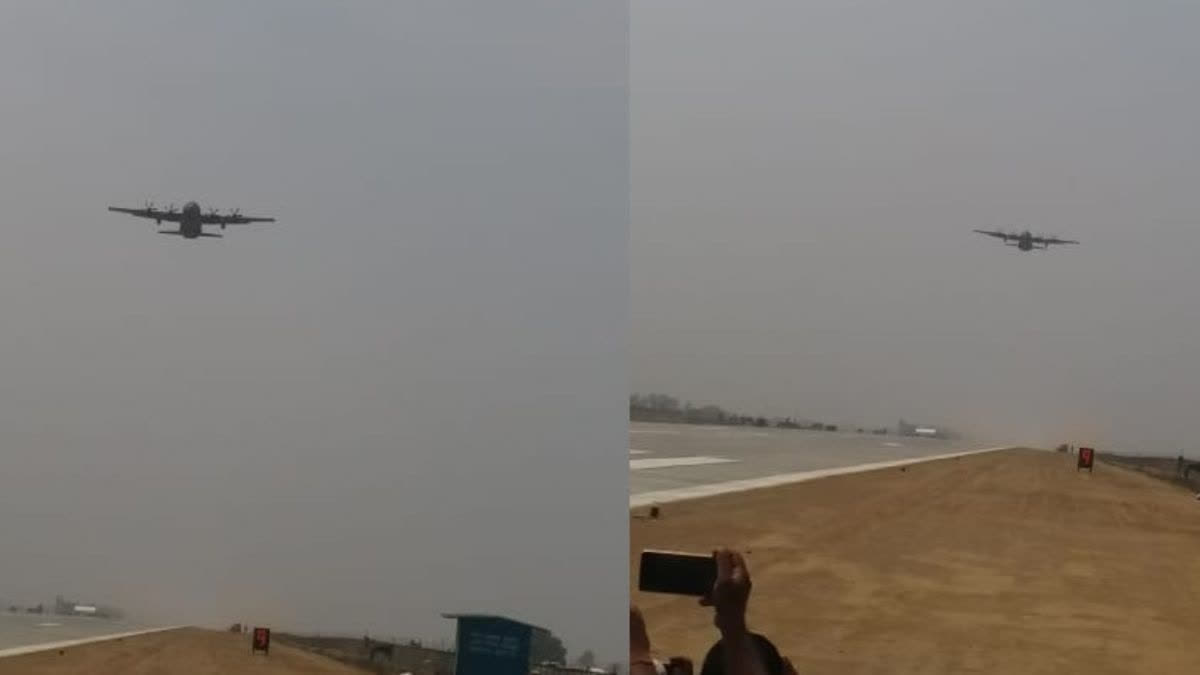SOURCE: RAUNAK KUNDE / NEWS BEAT / IDRW.ORG


A recent post on X by @FighterPiloting has sparked excitement among aviation enthusiasts, showcasing what appears to be the airframe fuselage of the Tejas MkII, an advanced variant of India’s indigenous Light Combat Aircraft (LCA) developed by Hindustan Aeronautics Limited (HAL). The image, taken in what looks like a manufacturing or assembly facility, provides a glimpse into the ongoing development of this next-generation fighter jet.
The image shows a partially assembled airframe, likely the fuselage section of the Tejas MkII, in a production environment. The structure is painted in a primer coat, a common practice during aircraft manufacturing to protect the frame before final assembly and painting. The fuselage appears to be in an early stage of assembly, with visible structural components and scaffolding around it, indicating that it is still under construction.
Continue readingSOURCE: RAUNAK KUNDE / NEWS BEAT / IDRW.ORG


The Japanese government has initiated discussions with India to join the joint development of a next-generation fighter jet under the Global Combat Aviation Programme (GCAP), a collaborative effort led by Japan, the United Kingdom, and Italy. According to a government source, Japan aims to reduce the substantial financial burden of the project by expanding the number of participating nations while strengthening security ties with India, a key South Asian power.
The GCAP, a trilateral initiative to design and build an advanced fighter jet to replace aging fleets, involves significant development costs estimated in the billions. By inviting India, Japan hopes to distribute these expenses and leverage India’s growing defense capabilities. Additionally, the move aligns with Japan’s broader strategy to promote stability in the Indo-Pacific region, where India plays a pivotal role.
Continue readingSOURCE: RAUNAK KUNDE / NEWS BEAT / IDRW.ORG


The Indian Army, having already placed initial orders for the indigenously developed Pralay tactical ballistic missile, is now planning to procure additional units to strengthen its strategic capabilities. This decision comes in response to escalating regional tensions with neighboring China and Pakistan, prompting a heightened focus on enhancing the Army’s precision strike capabilities to neutralize critical enemy infrastructure, including command centers and key military installations.
The Pralay missile, developed by the Defence Research and Development Organisation (DRDO), is a quasi-ballistic missile with a range of 150-400 kilometers and a payload capacity of up to 800 kilograms. Its ability to follow a low-altitude, non-linear trajectory makes it difficult to intercept, offering a significant tactical advantage. The missile’s precision and rapid deployment capabilities make it ideal for targeting high-value assets such as enemy headquarters, communication hubs, and logistical nodes in a conflict scenario.
Continue readingSOURCE: AFI


In a brazen display of misinformation, the Directorate General of Public Relations (DGPR) of the Pakistan Air Force (PAF) has released a new propaganda video that falsely showcases India’s BrahMos supersonic cruise missile as a Pakistani weapon. The video, which surfaced recently, has drawn widespread criticism for its deceptive portrayal, further eroding the credibility of DGPR PAF’s media campaigns. This incident adds to a growing pattern of misleading content from the PAF’s public relations wing, raising questions about the ethics of such tactics in a region already fraught with tensions.
Older propaganda video, posted on April 29, 2025, by the official DGPR PAF account on X, was titled “Pakistan Air Force Reaffirms Unwavering Commitment to National Sovereignty & Defence Excellence.” It featured a montage of military assets, including what was presented as a Pakistani missile. However, sharp-eyed observers quickly identified the missile as the BrahMos, a supersonic cruise missile developed through a joint venture between India’s Defence Research and Development Organisation (DRDO) and Russia’s NPO Mashinostroyeniya. The BrahMos, known for its Mach 2.8-3.0 speed and a range of up to 1,500 km in its extended versions, is a flagship of India’s defense capabilities, with no equivalent in Pakistan’s arsenal.
Continue readingSOURCE: AFI


The Indian Army’s Army Design Bureau (ADB), established in 2016 as a catalyst for indigenous defense innovation, is rapidly evolving into a powerhouse of technological advancement, driving the development of cutting-edge military equipment to enhance self-reliance under India’s ‘Aatmanirbhar Bharat’ initiative. Bolstered by the success of the ASMI 9mm submachine gun, designed by a serving soldier, the ADB is now expanding its ambit to develop advanced assault rifles tailored for the Indian Army.
By harnessing the expertise of uniformed engineers and innovators, collaborating with industry and academia, and facilitating Transfer of Technology (ToT) to local production partners, the ADB aims to localize critical defense technologies and enable mass-scale production.
Continue readingSOURCE: AFI


In a significant stride toward self-reliance in defense technology, India showcased its indigenous next-generation autonomous defense systems at the Babina Field Firing Ranges in Uttar Pradesh from April 23 to 25, 2025. The event, highlighted in posts on X, featured cutting-edge innovations aimed at modernizing the Indian Armed Forces and enhancing operational capabilities in diverse combat scenarios. Among the standout technologies displayed were the Sheshnag-150, a long-range swarm drone by Bengaluru-based NewSpace Research and Technologies (NRT), and the Sapper Scout, a multi-utility unmanned ground vehicle (UGV), underscoring India’s growing prowess in autonomous warfare systems.
The Sheshnag-150, developed by NRT, marked a milestone in India’s unmanned aerial capabilities. Named after the mythological serpent, this 150kg unmanned aerial vehicle (UAV) is designed for attritable warfare, focusing on overwhelming adversaries through coordinated swarm attacks. With a range exceeding 1,000 km, an endurance of five hours, and a payload capacity of 25-40 kg, the Sheshnag-150 is engineered for precision strikes deep into enemy territory. Its successful maiden flight, announced by NRT in February 2025, demonstrated its potential as a force multiplier.
Continue readingSOURCE: AFI


A growing rift is said to be emerging within the senior leadership of the Pakistan Army, with several powerful Corps Commanders reportedly at odds with Chief of Army Staff (COAS) General Asim Munir over recent developments related to cross-border operations in Kashmir and his increasingly hardline stance.
Sources familiar with the matter suggest that Lieutenant General Rahat Naseem Ahmed Khan (Commander XII Corps), Lieutenant General Syed Imdad Hussain Shah (XXX Corps), Lieutenant General Saqib Mehmood Malik (XXXI Corps), and Lieutenant General Muhammad Zafar Iqbal (Air Defence Corps) are among the senior commanders expressing strong reservations about Munir’s leadership direction.
Continue readingSOURCE: ANI


The United States approved a potential USD 131 million foreign military sale to India aimed at enhancing maritime security in the Indo-Pacific region. Announced by the Defence Security Cooperation Agency on Wednesday, the deal includes advanced SeaVision software, training, and support services to bolster India’s maritime domain awareness and strengthen strategic ties between the two nations.
Sharing a post on X, the US Department of State said, “State Dept authorises a Foreign Military Sales (FMS) case for India to purchase Indo-Pacific Maritime Domain Awareness software and related equipment for an estimated cost of $131 million.”
Continue readingSOURCE: ANI


In a continued wave of cyber offensives, Pakistan-sponsored hacker groups such as “Cyber Group HOAX1337” and “National Cyber Crew” made unsuccessful attempts to breach some websites yesterday. These hacking efforts were promptly identified and neutralised by cybersecurity agencies. Among the latest provocations, the websites of Army Public School Nagrota and Sunjuwan were targeted and attempted to be defaced with messages mocking the victims of the recent Pahalgam terror attack.
In another incident, a website catering to ex-servicemen’s healthcare services was defaced, signalling Pakistan’s growing frustration. There have been repeated attempts made by hackers operating from Pakistan to attack websites having linkages to children, old age veterans and other innocent people.
Continue readingSOURCE: PTI
)

Chinese Ambassador to Pakistan Jiang Zaidong met Prime Minister Shehbaz Sharif in Islamabad and exchanged views on the India-Pakistan tensions as Beijing kept abreast with the evolving situation. Official media here quoted a press release by the Chinese Embassy in Pakistan on Friday stating that Jiang met Sharif on Thursday and reiterated China’s earlier call for both India and Pakistan to exercise restraint.
China understands Pakistan’s legitimate security concerns and supports its efforts to safeguard national sovereignty and security interests, the press release quoted Jiang as saying.
Continue readingSOURCE: ANI


The Indian Air Force (IAF) showcased its operational readiness with an impressive flypast and landing exercise on the Ganga Expressway in Uttar Pradesh on Friday. The exercise was conducted on a 3.5-kilometre-long airstrip at Shahjahanpur, part of the under-construction expressway.
The drill featured take-offs and landings by advanced fighter and transport aircraft, including the Rafale, Jaguar, and Mirage jets. This strategic operation aimed to assess the expressway’s potential as an alternative runway during wartime or national emergencies.
Continue readingSOURCE: PTI


India will be asking global multilateral agencies, including the IMF, to have a relook at funds and loans provided to Pakistan, as New Delhi seeks to corner the neighbouring state diplomatically following the dastardly terror attack in Pahalgam last month which killed 26 tourists. “We will be asking all multilateral agencies to review the loans and support to Pakistan,” a government source said.
The IMF Executive Board is scheduled to meet Pakistan officials on May 9 for first review of the extended funding facility, and request for an arrangement under the resilience and sustainability facility. The IMF Board will evaluate fresh USD 1.3 billion arrangement for Pakistan under its climate resilience loan programme. It will also assess an ongoing USD 7 billion bailout package.
Continue readingSOURCE: PTI
)

Pakistan on Friday said it has a right to seek a meeting of the United Nations Security Council when appropriate as tensions heightened with India after the Pahalgam terror attack.
We see that all of this that is happening is in the context, in the backdrop of the situation in Jammu and Kashmir, Pakistan’s Permanent Representative to the United Nations Ambassador Asim Iftikhar Ahmad told a press conference here.
Continue readingSOURCE: PTI

Pakistan Prime Minister Shehbaz Sharif’s YouTube channel was blocked in India on Friday amid ongoing tension between the two countries following the deadly terrorist attack in Jammu and Kashmir’s Pahalgam.
“The content is currently unavailable in this country because of an order from the government related to national security or public order. For more details about government removal requests, please visit the Google Transparency Report,” read a message on the blocked channel.
Continue readingSOURCE: PTI


The Congress on Friday urged the Centre to act with firmness in the wake of the Pahalgam attack to “penalise” Pakistan for its continued export of terror and asserted this is a time for demonstrating our collective will as a nation to “teach Pakistan a lesson”.
Calling for national unity and resolve, the Congress also pressed for “time-bound accountability” into the “serious lapses” in security and intelligence in one of the most heavily-guarded regions of the country.
The opposition party made the assertions in a resolution passed by the Congress Working Committee (CWC) at its meeting which was chaired by party chief Mallikarjun Kharge. Former Congress presidents Sonia Gandhi and Rahul Gandhi, and general secretaries Jairam Ramesh, K C Venugopal and Priyanka Gandhi Vadra among others attended the meeting.